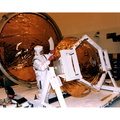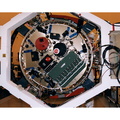
WIKIARCHIVES.SPACE
The Human Spaceflight Archive

Information
- Taken in
- Kennedy Space Center
- Author
- NASA
- Description
- An employee in the Payload Hazardous Servicing Facility (PHSF) sews thermal insulation material on the front heat shield of the Huygens probe during prelaunch processing testing and integration in that facility, with the probe's back cover in the background. The Huygens probe and the Cassini orbiter being processed at KSC are the two primary components of the Cassini spacecraft, which will be launched on a Titan IVB/Centaur expendable launch vehicle from Cape Canaveral Air Station. Cassini will explore Saturn, its rings and moons for four years. The Huygens probe, designed and developed for the European Space Agency (ESA), will be deployed from the orbiter to study the clouds, atmosphere and surface of Saturn's largest moon, Titan. The orbiter was designed and assembled at NASA's Jet Propulsion Laboratory in California. Following postflight inspections, integration of the 12 science instruments not already installed on the orbiter will be completed. Then, the parabolic high-gain antenna and the propulsion module will be mated to the orbiter, followed by the Huygens probe, which will complete spacecraft integration. The Cassini mission is targeted for an Oct. 6 launch to begin its 6.7-year journey to the Saturnian system. Arrival at the planet is expected to occur around July 1, 2004.
- Created on
- Tuesday 22 April 1997
- Albums
-
Locations / OSM-4.915832801313164
US SPACE PROGRAM / PROBES / SATURN / CASSINI/HUYGENS / Rocket preparation
- Source link
- https://science.ksc.nasa.gov/gallery/photos/1997/
- Visits
- 40
- Rating score
- no rate
- Rate this photo
- License
- CC BY-NC-ND
- Modified by WikiArchives
- No (original)
- Downloads
- 0
Powered by Piwigo






